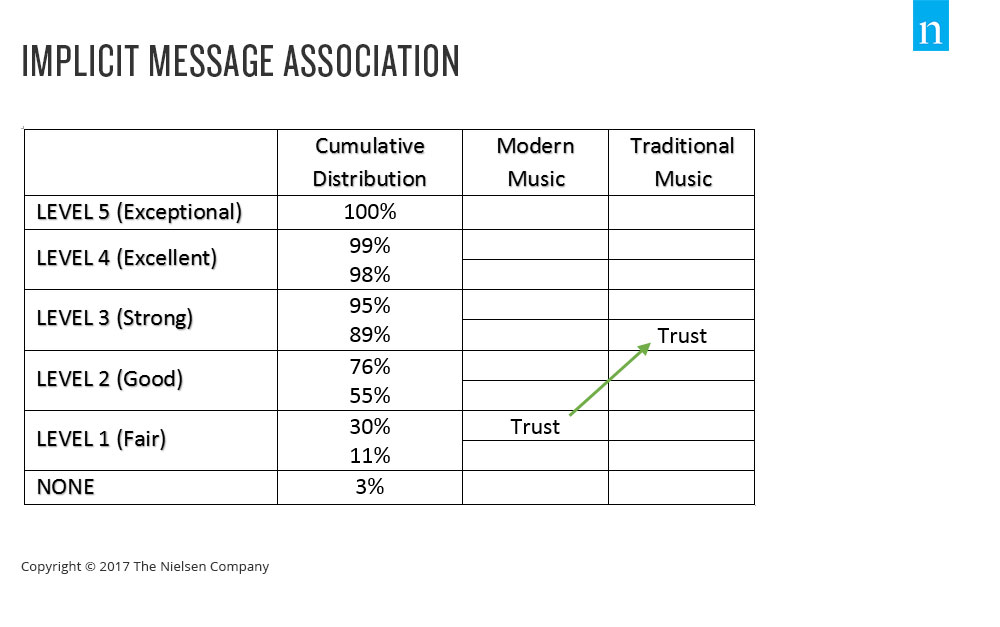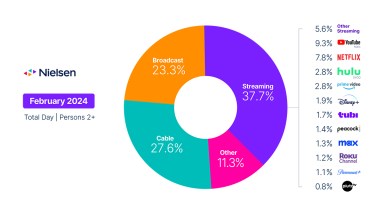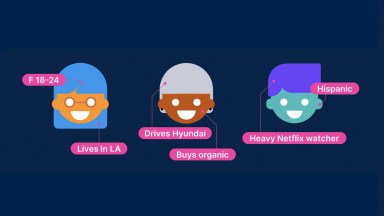Measuring an ad’s ability to communicate trust is a tricky business: perceptions of trust can be non-conscious, formed almost immediately and biased by subtle factors.
Given these nuances, explicit research methods aren’t sufficient. A German financial institution recently learned this the hard way and turned to neuroscience methods to better understand the impact of its latest creative.
Communicate a sense of trust
For its latest creative, the financial firm created a TV ad that focused on the performance and strength of the investment services that its brand provides. Like all TV ads, the brand wanted the ad to emotionally engage audiences and be memorable. It was also important to communicate a sense of trust.
Wanting to evaluate the effectiveness of two different versions of the ad, the company enlisted Nielsen Consumer Neuroscience to determine if different types of music would have an effect on the ad’s ability to communicate trust in the brand.
Many things can contribute to the perception of trust for a brand, including the advertising creative and its emotional tone. Music is well known for its ability to communicate a type of mood, but not all music interacts with ad creative in the same way, and it can be difficult to predict just how an audience will respond to a particular music choice without good research. Based on past experience, the company was concerned about whether traditional self-reporting measures would be able to capture the impact of this subtle change.
Soundtrack selection using EEG
The bank’s ad consisted of a series of visuals depicting people confidently striving to achieve their goals, doing extraordinary things and looking to the future. The ad was fast-paced and the voice-over explained how the bank would be the consumer’s trusted partner and play a role in looking out for their future. However, the company was unsure what type of music would best support the creative. The bank had two soundtrack options: modern and traditional. So we tested two versions of the ad, the only difference being the soundtrack.
Ad A: The music in this version was upbeat, energetic and modern. It had a strong focus on drums and synthesized instruments.
Ad B: The music in this version had a more classical feel. It was still up tempo, but it was more traditional and used classical instruments.
We tested both versions of the ad using electroencephalogram (EEG) technology in our lab in Germany. By using EEG, we were able to measure engagement with every second of the ad to identify which parts are emotionally engaging and/or memorable. We can also use the EEG data to predict whether watching the ad will likely drive future behaviors (e.g., purchase, website visit, tell a friend, etc.). During the test, we also diagnosed which elements of the ad weren’t working so well to highlight areas that could be improved. Participants were randomly assigned to watch either Ad A or Ad B.
Non-conscious level testing
In addition to watching the ads, participants performed a task designed to assess how well the ads communicated key messages, on a non-conscious level. In this section of the study, participants were shown a series of words on the screen. Words appeared quickly, about one word per second. Key words of interest were included within each string of words. The bank selected these key words, which were mixed with others so the participants were unsure what was being tested. During the study, all of the words were repeated several times. While the participants were shown the words, they were asked to press a button every time they saw a red letter. That kept them watching the word strings and further masked the goal of the study. For the ads, the word “Vertrauen” (German for “trust”) was of critical interest.
During the study, participants’ brain responses to each of the words were recorded and time-stamped using EEG. And here’s the interesting thing: Even though the participants were performing a somewhat irrelevant task, their brains couldn’t help but automatically read, and implicitly evaluate, the meaning of the words presented to them. To get a baseline response, the participants performed these tasks before being shown the ads. We then had them do it again after viewing the ads to measure whether watching them changed how their brains reacted to any of the words.
The brain response that we measured during the word task is a particular brainwave called the P3. The P3 has a long history in academia, with over 1.5 million journal articles published about it. What does the P3 tell us about the response to these target words?
The pre-post change in the P3 is a measure of the non-conscious brain response and is an indicator that the word is more or less meaningful in response to the ad in some way. If the P3 response was larger to a particular word after the participant has been exposed to the ad (compared with before the participant saw an ad), then the ad has given more meaning to the word. In these cases, the ad has affected implicit perceptions of that idea in the brains of the participants.
So, did the music make a difference to overall ad performance? And did either soundtrack better communicate trust?
The better fit
The results showed that the more traditional music significantly outperformed the modern track because it created stronger emotional engagement with viewers. This emotional boost, however, wasn’t constant throughout the ad, and the results don’t speak to song preference. Rather, the traditional music was better able to support key moments throughout the ad—building the dramatic tension to peak at particularly salient points. The traditional music was a better fit with the feel of the ad, and this synchrony actually helped the visuals and voice-over to perform better.
Music choice also made a big difference with the ad’s ability to communicate trust. Again, the traditional track was the winner. Results of the non-conscious message association test showed that the ad with the modern music only minimally managed to communicate trust. It reached a level 1.5 (on a scale of 0 to 5), which is in the bottom 30% of our database for message communication. Comparatively, the ad with the traditional music communicated trust at a level 3, putting it within the top 30% of our database.

Stability versus risk
It’s likely that the traditional music better communicated trust for a number of reasons. For example, people may associate the classical instruments more implicitly with ideas of longevity and stability than the synthesized sounds in the modern music. It’s highly likely that the stronger emotional connection created by the traditional music, which we saw peak at key moments in the ad, meant that these moments were more impactful to ad communication. Notably, some of these peaks occurred when the voice-over mentioned being a trusted partner and when the visuals depicted people shaking hands.
Our client was pleased that neuroscience testing revealed a clear path forward and that the methodology suggested other ways to improve the ad. For the final ad, the bank selected the traditional soundtrack and aired that version.
Have we learned that traditional music is more trustworthy than modern music? No. We have, however, learned that it’s important to carefully match ad soundtrack to the creative: Not all music interacts with ad creative in the same way, and good research is needed to understand the impact of this choice on whether an ad can create an emotional connection, communicate an intended message and affect future behavior.
This article was originally published in INsights, the quarterly publication about applying consumer neuroscience into business, the official source of the international Neuromarketing Science & Business Association.



